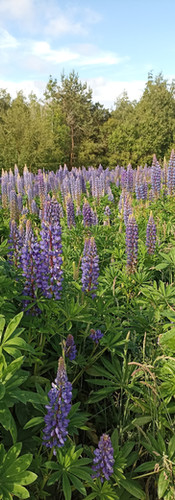The vanished village of Oakbank
- Editor
- Jul 5, 2022
- 4 min read
Today, most of us in the area know Oakbank as a street name in East Calder, a road that leads to nowhere but lends its name to businesses and clubs in the area.
However, the village of Oakbank used to be a very busy thriving settlement with all its own facilities. It had a life-span of 120 years, having sprung up in 1864 as a working village for the Oakbank Oil Works, and the last resident moving out in 1984. While there are a few businesses left at Oakbank today, it could no longer be described as a settlement in its own right.

The Oakbank Oil Company Ltd was one of the longest-surviving companies during West Lothian’s oil industry years. The Company ran the village in a paternalistc manner - typical of all the oil companies at the time. It built houses for the workers and an Institute Hall, where games, newspapers and periodicals were available. A West Lothian Courier article of November 1902 reports that a billiard hall was proposed for the Institute, in order to ‘‘lessen the attractions already in our midst of a less beneficial character.’’
A bowling green and a football pitch were provided, and a school was opened in 1901 next to Hoghill Farm, built by the East Calder and Kirknewton Parish School Board. Oakbank even boasted its own Cooperative Society for a time, the Oakbank Co-op being formed in 1872.
There were annual games and Gala days. At various times during its busy history, Oakbank had its own tennis club, Burns Club, Oakbank WRI, mission chapel, football teams (the Oakbank Thistle and Oakbank Amateurs), a rifle club and a golf club.
The oil works, the raison d’etre of the village, were demolished in 1932. Various allotment schemes were put in place, mainly on the initiative of the residents, for small scale agricultural enterprise on the land adjacent to the former works. Then the outbreak of war solved the unemployment problem for a while.

After the war the village still had two shops, a primary school with 3 teachers and 73 pupils, and a football team. But the houses were deteriorating and the residents gradually moved out into modern houses in East Calder and elsewhere. The last resident, Mrs Shearer, who had kept the village shop for years, moved out in 1984 and the bulldozers moved in.
Today, the Oakbank Bowling Club remains and there is a small number of houses near to the site of the original village.
A survery of the Oakbank housing carried out in 1914 provides a description of the houses. Each house had a coal cellar, and there was a wash house for every four houses - an outdoor wash house where you lit a fire under the big copper to wash the clothes, having first to carry the water in buckets from the wells in the street. There were no indoor bathrooms - there were ashpits and privvies, that a man with a horse and cart would come round and empty every week. The Company usually provided this service.
Tragedy at Oakbank
In 1921, a fire broke out in one of the tenements, claiming the lives of 3 people and leaving 11
families homeless. The first port of call for the residents, naturally, was the Works, and the alarm was raised there. The Works Brigade (12 men from the Works Fire Station) attended quickly but the village hydrants were inadequate. The West Lothian Courier of 11th March 1921 reports that the Oil Works Manager ‘‘got into telephonic communication’’ with the Edinburgh Fire Brigade, although by the time they arrived the building was beyond saving. The three victims were buried in Kirknewton Churchyard.
Oakbank Bing
The Oakbank Oil Works processed millions of tonnes of shale oil from mines at Calderwood and Newfarm (now the Lanthorn Centre at Dedridge). An aerial ropeway used to transport shale from the Dedridge mine to Oakbank. The Bing is the waste shale that was piled up once the oil had been extracted. Over 3 million tonnes were dumped here, and it used to tower high above the houses, as can be clearly seen in this photo.

Livingston Development Corporation removed shale from the bing as it was slipping into the Linhouse Water, and put topsoil on top. The bing has been reclaimed in recent years as a nature reserve and is a site of ecological and historical importance covering around 51 acres. The volunteer group Friends of Almondell & Calderwood Country Park (www.facebook.com/friendsofalmondell) have put in a lot of work at Oakbank to plant trees, flowers and maintain the environment.
A network of paths over and around the bing makes for a beautiful peaceful spot for a walk. I came face to face with a young deer here one sunny afternoon in June, and it’s alive with birds. It’s hard to imagine that this was an industrial site.
You can access Oakbank Bing either from the end of Oakbank Road, or from the Oakbank Carpark off the A71.
Published in Konect July 2022. First published in Konect 2009
Author: Helen-Jane Gisbourne

![FACEBOOK [PROFILE IMAGE 6].jpg](https://static.wixstatic.com/media/1a0618_344774a90079463f9b54d132da8bab5a~mv2.jpg/v1/crop/x_46,y_126,w_1109,h_960/fill/w_194,h_168,al_c,q_80,usm_0.66_1.00_0.01,enc_avif,quality_auto/FACEBOOK%20%5BPROFILE%20IMAGE%206%5D.jpg)








I can remember going through to Oakbank from Airdrie to visit relatives in about 1947-48,
We spent the day with the younger ones of the family on a bing which I thought was behind company cottages similar to those in the opening photograph on the website , although it could have been two story buildings - sorry so long ago now!
I am sure I had a photo somewhere, Oh, I forgot, the name of the family was Shearer and I remember my Father saying that he was embarrassed as she refused to move out of her house when asked,